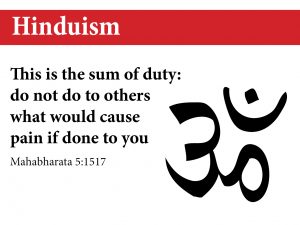2.7 A meditation on the Hindu Namaste greeting
Materials required: A listing of the 13 expressions of the Golden Rule. To access this listing, click here. To avoid printing all five available languages, select only the language you need.
Steps:
-
- Prepare yourself
Prepare yourself for meditation by any means that you find to be effective. You may want to consider Appendix 4: Tips for preparing for meditation and reflection. - The Golden Rule
In a slow and reflective fashion, read the 13 expressions of the Golden Rule. Take as much time as you need with these writings.
- Prepare yourself
- Hindu Namaste greeting“I honor and respect the divinity within you
I honor the place within you
In which the entire universe resides
I honor the place within you of love, of light, of peace
I honor the place within you where
When you are in that place within you
And I am in that place within me
There is only one of us”.Spend some time reflecting on this statement, which is one of a number of ways of expressing the HinduNamaste greeting. It is common for Hindus to greet one another with the Namaste gesture. Bringing the palms of the hands together in a prayer position in front of the chest, they bow to one another while saying the word “Namaste”. The bowing of the head is a gracious form of extending friendship in love and humility. The bow also symbolizes the negation or reduction of one’s ego in the presence of another. By way of thisNamaste greeting, Hindus recognize the presence of the divine in one another and in all of creation.Spend as much time as you need reflecting on these words associated with the Hindu greeting. - Interacting wisdom statements
You have had some time to reflect on both the words of the Hindu greeting and the 13 expressions of the Golden Rule. How do these two interact for you? To aid your reflection, consider one or more of the following questions:- Do the words of the Hindu Namaste greeting give added meaning to the 13 expressions of the Golden Rule? If so, how do they add meaning? Conversely, do the 13 expressions of the Golden Rule give added meaning to the Hindu greeting? Explain.
- Which of the 13 statements of the Golden Rule relate most directly to the words of the Namastegreeting? Explain.
- Are there ways in which the words of the Hindu greeting do not relate to the 13 expressions of the Golden Rule? Explain.
- In your own words
In your own words, re-write the words of the Namaste greeting, incorporating any new insights that you have garnered from your reflection thus far. - Going deeper
Read the written reflections you have made throughout this meditation. To deepen your reflection, consider one or more of the following questions:- What was it like for me to do this meditation exercise?
- At what points during this period of reflection was I moved? Inspired? Challenged?
- What questions or issues have been raised for me?
- What new insights have I gained in this process?
- What did I learn about myself?
- As a result of this meditation, what aspects of my life might I consider changing?
- As a result of this meditation, I feel moved to……
- What did I learn about the Golden Rule? About the world we live in?
- Record your thoughts
In your journal, record any thoughts, comments or insights garnered in Step #6 and in the entire process. - A group experience
For instructions on how to adapt this meditation for a group experience, see Appendix 3: Application to a group experience.

